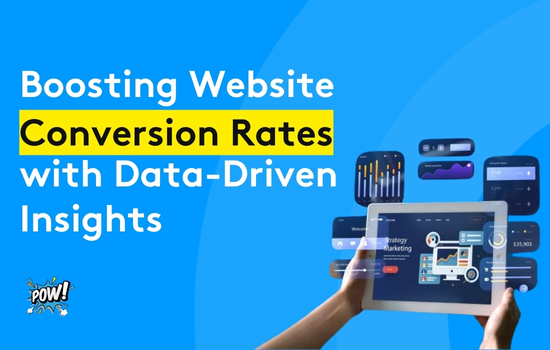Did you know that over 60% of customers are happy to share their information for personalised offers? According to research, 75% of business leaders use data to make decisions. As a business owner, you’ve likely seen studies showing how important data is for business growth.
Data and analytics are essential for online marketing. Unlike offline marketing, online marketing lets you track and use data to make smart choices. If you want to increase your website’s conversion rates, data-driven insights are key.
Every business can get data from their campaigns, but not all use it to boost growth. How do you turn data into helpful insights? How can these insights improve your website conversion rates?
This guide will explore the link between data and marketing and show how analytics tools can help you get more conversions.
Unveiling Data-Driven Insights for Website Conversion Rates
Business data helps organisations understand how successful their marketing campaigns are. It shows where to spend money and how to measure the return on investment (ROI). Data is crucial for marketing success. Let’s start with the basics of using data-driven insights to improve website conversions.
Understanding Data-Driven Insights
Data-driven insights are conclusions drawn from analysing large amounts of data. Analytics tools help generate these insights, which are then used to make strategic decisions based on facts and figures.
Organisations that use a data-driven approach rely on hard data instead of intuition or assumptions. This method allows them to make informed and timely decisions based on market trends.
Synergy Between Marketing & Data Insights
Marketing and data insights go hand in hand. Data-driven insights help marketers make smart decisions about their campaigns and overall strategies. Here are some practical ways data-driven insights are used in marketing:
Identifying Target Audience: Data insights help pinpoint the most valuable audience based on demographics, buying behaviors, and brand engagement.
Optimising Campaigns: By analysing key metrics like click-through rates, conversion rates & engagement, marketers can fine-tune campaigns for better performance.
Personalising Marketing Campaigns: Personalised marketing messages are crucial for success today. Data insights enable the customisation of messages, which, according to Google, can boost conversion rates by 90%.
Marketing Attribution: Data insights help attribute sales and conversions to specific campaigns or channels, allowing marketers to allocate budgets more effectively and focus on the strategies that drive the most sales and revenue.
Types of Insights Driven by Data
You can generate and analyse different data-driven insights to optimise your website for higher conversion. These include –
Quantitative Insights: These are numerical data such as traffic, bounce rates, conversion rates, click-through rates, and time on site. They let you study user behavior and its impact on conversion rates.
Qualitative Insights: These non-numerical insights include feedback, customer support tickets, and social media comments. Using these, you can identify specific pain points or areas of the website that need improvement.
Behavioral Insights: These focus on user activity on the website, such as click paths, navigation patterns, and search queries. These give you a better understanding of the needs and aspirations of your users.
Competitor Insights: It uses third-party and open data to study strengths, weaknesses & areas for differentiation. It lets you know, your website stacks up against competition.
Significance of Data-Driven Insights in Maximizing Conversion Rates
Data-driven insights are crucial for enhancing user experience and maximising website conversion rates. Here’s why they’re important:
Identify Pain Points: Data-driven insights help pinpoint areas where your website struggles to convert users into customers, allowing to address these issues effectively.
Study User Behavior: By analysing data, you can understand how users interact with website, which elements engage them most & why they may leave without converting.
UX Optimisation: Data-driven insights enable you to optimise user experience by tackling common problems like slow load times or confusing navigation, ultimately improving conversion rates.
Track Progress: With regular changes to your website, data-driven insights provide validation by tracking key performance indicators, ensuring that modifications contribute to improved conversion rates.
Critical Factors Influencing Website Conversion Rates
The conversion rate measures the percentage of visitors to a website who take a desired action, like making a purchase or signing up for a newsletter. Key factors that affect website conversion rates include:
Usability and Navigation: Visitors should easily find what they need on the website without facing obstacles. Easy-to-access navigation buttons and logical page structures are crucial.
Design and Layout: A well-designed website that appeals to users and provides a good user experience can significantly impact conversion rates. Avoid clutter & focus on design elements that resonate with target audience.
Content Quality and Relevance: High-quality, relevant content is essential for attracting and retaining visitors. Whether it’s product descriptions or blog posts, content that resonates with the audience improves conversion rates.
Load Time and Performance: Pages should load quickly to keep visitors engaged. Slow loading times can lead to visitors leaving the site, so optimising performance is crucial for conversion rates.
Social Proof and Testimonials: Social proof, like customer reviews and testimonials, builds trust with visitors and increases conversion rates. When users see positive feedback, they’re more likely to become paying customers.
Collecting Data for Analyzing Website Conversion Rates
Analysing conversion rates relies heavily on data collection, and here’s a detailed look at how it’s done:
Role of Analytics Tools:
Analytics tools are essential for understanding conversion rates. They provide insights into user interactions on a website, helping marketers identify what prompts users to take actions like adding products to a cart or subscribing to newsletters. These tools also highlight areas for improvement, crucial for optimising conversion rates.
Types of Data to Collect for Conversion Rate Analysis:
Understanding user behavior requires collecting various types of data. This includes customer demographics like location, age, and device usage, as well as keywords, marketing channels, and website activity.Data on purchases, popular products, and drop-off points are also important. These insights enable personalised campaigns and content tailored to user preferences.
Best Tools for Data Collection:
Businesses utilise a range of tools for data collection and analysis. Popular options include Google Analytics, Adobe Analytics, SurveyMonkey, and HubSpot. Tools like HotJar, Crazy Egg, and FullStory offer insights into user behavior through heatmaps and session recordings. Optimisely, VWO Testing, and Instapage facilitate A/B testing and optimisation of marketing strategies for improved conversion rates.
Analysing Data to Enhance Website Conversion Rates
To boost your website’s conversion rate, consider these data analysis techniques:
Funnel Analysis: Track the user journey from site visit to conversion. Identify where users drop off & take correct actions to streamline conversion process.
Segmentation Analysis: Divide the user base into segments based on demographics, behavior, etc. Understand how each segment interacts with the website and tailor the user experience for better conversion rates.
Time on Page Analysis: Monitor how long users spend on each webpage. Analyse which pages are most engaging and to optimise them to increase conversion rates.
Exit Intent Analysis: Track where users exit your website. Use targeted messaging or offers to encourage them to stay, reducing bounce rates and increasing conversions.
Boosting Conversion Rates Using Data-Driven Methods
Data provides actionable insights for enhancing conversion rates, and here are some effective methods for leveraging that intelligence:
Personalisation: Customise the user experience based on individual preferences and behavior. Data analysis enables understanding user preferences, facilitating a personalised experience that can drive higher conversion rates.
Mobile Optimisation: With mobile devices dominating website browsing, optimising your site for mobile users is crucial. Enhancing user experience on mobile devices can lead to greater engagement and ultimately increase conversion rates.
Content Optimisation: Tailoring content to resonate with your target audience is essential for boosting conversions. By analysing data, you can determine the language and messaging that best engages your audience, optimising content for improved conversion rates.
Applying Data Insights for Enhanced Conversion Rates
Data-driven optimisation is crucial for businesses aiming to enhance website conversion rates. Let’s explore why it’s important, how to implement changes effectively, and some common examples based on data-driven insights.
Importance of Data-Driven Optimisations for Conversion Rates Improvement:
- Identifying Areas of Improvement: Data insights pinpoint weaknesses in underperforming websites.
- Informed Decision-Making: Fact-based decisions replace assumptions & intuition.
- Testing Variations: Testing different website versions to maximise conversions.
- Enhancing User Experience: Improving the likelihood of visitors becoming customers.
Best Practices for Implementing Changes Based on Data Insights:
- Set Clear Goals: Align changes with business objectives.
Prioritise Impact: Start with changes likely to have the most significant impact. - Run Tests: Conduct A/B testing before implementing changes.
- Gradual Implementation: Implement changes gradually to gauge their impact.
- Monitor Results: Track changes’ effects on conversions.
- Document Changes: Documenting allows teams to evaluate changes’ success.
Examples of Changes to Implement Based on Data Insights:
- Landing Page Redesign
- Navigation Redesign
- Mobile-First Approach
- Streamlining User Experience
- Optimising Website Speed
- Improving Checkout Process
- Altering CTA Elements
- Content Personalisation
Assessing the Effectiveness of Changes on Conversion Rates
Testing is pivotal for enhancing website conversion rates, enabling businesses to discern what resonates best with their audience. Let’s delve into why it’s crucial, the types of tests conducted, and their impact on conversion rates.
Importance of Testing for Website Conversion Rates Improvement:
- Identifying Optimal Design: Testing aids in discovering the most effective website layout and design that resonates with your audience.
- Audience Segmentation: Catering to diverse user segments by optimising the website to meet their unique needs.
- Validating Assumptions: Testing helps validate assumptions about the market and audience preferences.
- Continuous Improvement: Constantly testing and refining changes ensures your website stays ahead in the competitive landscape.
Types of Tests for Website Conversion Rates Improvement:
- A/B Testing: Compares two versions of a webpage to determine more effective one.
- Multivariate Testing: Tests multiple variations of webpage elements simultaneously to identify the best combination for higher conversions.
- User Testing: Tracks interactions to identify usability issues & areas of improvement.
- Heatmap Testing: Visualises user interactions on the website to pinpoint areas of interest and improvement.
- Exit Intent Pop-up Testing: Utilises pop-ups to retain users and enhance conversions upon exit.
Examples of Testing Tools for Measuring Impact on Conversion Rates:
- Google Optimise
- Crazy Egg
- FullStory
- Adobe Target
- WebPageTest
Conclusion
In summary, we’ve covered the fundamentals of data-driven insights, factors influencing conversion rates, methods of data collection for analysis, and strategies for improving conversion rates.
We’ve also explored the significance of testing and best practices for implementing data-driven insights on your website, along with the tools used for data collection and measuring impact on conversion rates.
Ultimately, data-driven insights are crucial for maximising website conversion rates as they provide a clear understanding of user interactions. By analysing, you can uncover patterns, trends & areas for improvement that drive growth.
Adopting a data-driven approach enables informed decision-making, steering clear of assumptions and gut feelings.
In today’s ever-evolving digital landscape, data-driven insights are essential for businesses to remain competitive and thrive.





